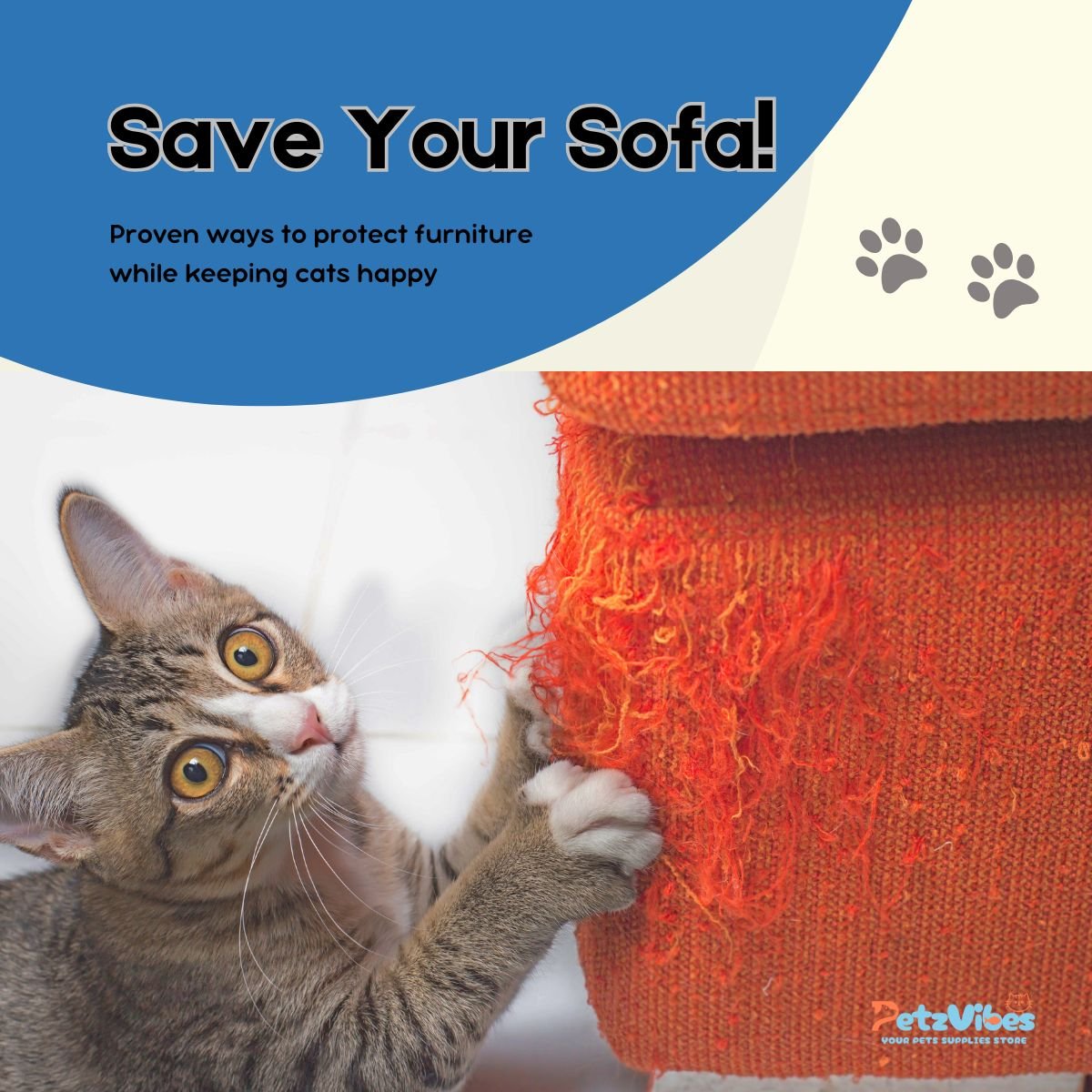How to Stop Cats From Scratching Furniture – Your brand-new couch may look like it survived a jungle attack, but your cat isn’t being destructive out of spite. That shredded upholstery? It’s natural feline behavior. You’ve tried the sprays, the sticky tapes, and even the water bottle, but nothing works long term. Here’s why those methods fail and what does: redirecting their instincts, not fighting them.
According to ASPCA, scratching is vital for cats’ physical and emotional health, stretching, marking territory, and relieving stress. The secret isn’t stopping the behavior, but giving them better options.
In this guide, you’ll discover seven vet-approved solutions that protect your furniture while keeping your cat happy and healthy. No punishment, no guilt – results that work with your cat’s nature, not against it. Let’s transform your home from a scratch zone to a peaceful coexistence!
Why This Guide is Different
Most blogs tell you to “buy a scratching post” and call it a day. But if that worked, you wouldn’t be here! This guide covers:
- The hidden reasons your cat ignores scratching posts (and how to fix it).
- Cheap, DIY tricks vets use (like aluminum foil hacks—do they really work?).
- Real training timelines (spoiler: overnight fixes are myths).
Ready to save your furniture and keep your cat happy? Let’s go!
🐾 Key Takeaways: Stop Cat Scratching Effectively
- Scratching is natural – Cats scratch to mark territory, stretch muscles, and maintain claws (never punish this instinct)
- Redirect, don’t restrict – Provide tall sisal posts near favorite scratching spots + reward use with treats
- Deterrents work best combined – Use sticky tape/aluminum foil with scratching alternatives
- Trim claws regularly – Prevents damage; pair with nail caps (like Soft Paws) if needed
- Texture matters – Test materials (sisal, cardboard, carpet) to find your cat’s preference
- Training takes 2-4 weeks – Consistency with positive reinforcement is critical
- Declawing is harmful – Linked to chronic pain; opt for scratching posts and environmental enrichment instead
🐾 Why Do Cats Scratch? (The Science Behind the Shredding!)
You might think your cat is scratching your couch to annoy you. But here’s the truth: your cat can’t help it! Scratching is hardwired into their DNA. Here’s why:
1. It’s Like a Cat Gym Session 💪
- Stretching: Cats scratch to stretch their back and shoulder muscles (like yoga for felines!).
- Claw Maintenance: Scratching removes dead layers from their claws, keeping them sharp and healthy.
2. They’re Saying, “This is MINE!” 🏡
-
Cats have scent glands in their paws. When they scratch, they leave behind:
- Visual marks (look at me!).
- Smelly signals (invisible to humans, but clear to other cats).
3. Stress Relief (Yes, Really!) 😌
-
Scratching helps cats:
- Burn off nervous energy.
- Feel safe in their territory (especially in multi-cat homes).
But here’s the kicker: Punishing your cat for scratching won’t stop it—it’ll just make them sneakier. The key? Give them better options!
🚫 What NOT to Do: 5 Common Mistakes That Make Scratching Worse
You love your cat, but shredded furniture is driving you crazy. Before you try another quick fix, stop! Many well-meaning owners accidentally make scratching habits worse. Here’s what to avoid:
1. Yelling or Spraying Water 💦
- Why it fails: Cats don’t connect punishment with scratching—they learn to do it when you’re not around.
- What to do instead: Redirect to a scratching post (more on this later!).
2. Declawing (Never the Answer!)
- The truth: Declawing is like amputating a human fingertip—it’s painful and can cause lasting behavioral problems
- Humane alternative: Try Soft Paws nail caps or regular claw trims.
3. Buying the Wrong Scratching Post
- Big mistake: Choosing a wobbly, too-short, or carpeted post (many cats hate carpet!).
- Fix: Opt for tall, sturdy sisal posts—cats prefer textures that “shred” (like your couch!).
4. Ignoring Their Favorite Spots
- Example: If your cat always claws the corner of the sofa, placing a post across the room will not help.
- Pro tip: Put scratchers directly in front of their target zone.
5. Giving Up Too Soon
-
Patience pays: Training can take 2-4 weeks. Consistency is key!
Remember: The goal isn’t to stop scratching—it’s to teach your cat where to scratch. Up next: the step-by-step plan to make it happen!
🎯 Training Strategies That Actually Work: A Step-by-Step Guide
Now that you know what not to do, let’s focus on proven techniques to redirect your cat’s scratching. These vet-approved methods teach your cat where to scratch—without punishing their instincts.
Step 1: Choose the Right Scratching Post
Not all scratchers are created equal! Cats are picky about:
✔ Material: Sisal rope > cardboard > carpet (most cats prefer textures they can shred).
✔ Stability: Wobbly posts scare cats—pick one with a heavy base.
✔ Placement: Put it near their favorite scratching spot (don’t hide it in a corner!).
Pro Tip: Rub catnip on the post to attract your cat.
Step 2: Make Furniture Less Appealing
Use harmless deterrents to protect your couch while training:
- Sticky tape: Cats hate the feel of sticky paws (try Sticky Paws tape).
- Aluminum foil: Lay it on furniture—many cats dislike the sound/texture.
- Citrus spray: Lightly spritz fabrics (cats hate citrus smells).
Note: Deterrents work best when paired with a good scratching post!
Step 3: Reward Good Behavior
Positive reinforcement is 10x more effective than punishment:
- When you see your cat use the post, say “Good job!” and give a treat.
- Ignore furniture scratching—don’t react (negative attention still rewards them!).
Step 4: Trim Claws Regularly
- Short claws = less damage. Never declaw—trim every 2-3 weeks.
- Use cat-specific clippers and avoid the quick (pink part inside the nail).
Scared of trimming? Try nail caps (like Soft Paws) as a temporary fix.
Step 5: Be Patient & Consistent
- Training takes 2-4 weeks. Don’t give up!
- If your cat regresses, revisit steps 1-4.
🛠️ DIY Scratching Solutions: Budget-Friendly Fixes That Actually Work
Let’s face it – cat furniture can be surprisingly expensive. But what if I told you some of the most effective scratching solutions can be made from items you already have at home? These DIY options aren’t just cheap alternatives; many cats prefer them to store-bought products because they can be customized to your cat’s preferences.
The Ultimate Cardboard Cat Scratcher (That Costs Nothing)
Do you know those Amazon boxes piling up in your recycling bin? They’re about to become your cat’s new favorite toy. Here’s why cardboard works so well:
- The corrugated texture perfectly satisfies that shredding instinct
- It’s lightweight so that cats can dig their claws in
- You can easily replace sections as they wear out
Step-by-Step Construction:
- Select a sturdy box – double-walled cardboard works best
- Cut into 12-inch wide strips (length depends on desired size)
- Tightly roll strips, gluing every 2-3 layers with pet-safe adhesive
- For extra stability, glue the finished roll to a wooden base
- Sprinkle with organic catnip to encourage initial interest
Pro Tip: Make several at once and rotate them weekly to maintain novelty. Cats get bored with the same scratcher!
Transforming Household Items With Sisal Rope
That old side table you were going to toss? It’s about to become a cat-approved scratching station. Wrapping items with sisal rope (available at any hardware store) creates durable scratching surfaces that last for years.
Why sisal beats carpet:
- The rough texture helps remove claw sheaths naturally
- It frays beautifully, satisfying that destructive urge
- Doesn’t trap odors like fabric can
Installation Guide:
- Choose stable furniture legs or create a simple wooden frame
- Start wrapping at the bottom, using hot glue every few inches
- Keep tension tight – loose wraps are less satisfying to scratch
- For tables/chairs, wrap just two legs to start (let your cat choose)
Creative Furniture Protection Strategies
Sometimes the best solution is to create a physical barrier while training. These methods protect your furniture without chemicals:
- Removable Fabric Armor
- Use old blankets or towels pinned around furniture corners
- Secure with double-sided tape (cats hate sticky surfaces)
- Choose textures your cat dislikes (silk, crinkly fabrics)
- The Upside-Down Carpet Trick
- Cut carpet samples to size
- Place the pile side down on the scratch zones
- The rough backing deters most cats
- Plastic Runner Solution
- Available at hardware stores
- Place the nubby side up on furniture arms
- Temporary but highly effective
Cost Comparison Table: DIY vs Store-Bought
| Solution | Materials | Cost | Effectiveness | Longevity |
|---|---|---|---|---|
| Cardboard Scratcher | Recycled boxes | $0 | ⭐⭐⭐⭐ | 2-4 weeks |
| Sisal Wrapped Leg | Sisal rope + glue | $8 | ⭐⭐⭐⭐⭐ | 6-12 months |
| Furniture Covers | Old fabrics | 0−10 | ⭐⭐⭐ | Varies |
Remember: The goal isn’t to eliminate scratching – it’s to redirect it to appropriate surfaces. These DIY solutions give your cat acceptable outlets while protecting your furniture during training.
🐱 The Real Reasons Your Cat Ignores the Scratching Post (And How to Finally Fix It)
It’s frustrating when your cat completely ignores that expensive scratching post you carefully selected. Before you give up, let’s examine why this happens and how to make scratchers appealing to your feline friend.
Understanding Feline Scratching Preferences
Through years of observing cat behavior, veterinarians and behaviorists have identified five primary reasons cats reject scratching posts:
-
Texture Matters More Than You Think
-
- Many commercial posts use low-quality carpet that doesn’t satisfy the need to shred
- Cats instinctively prefer materials that “give” under their claws
- Solution: Offer a texture buffet – sisal, cardboard, wood, and carpet samples to identify preferences
-
Location, Location, Location
-
- Placing a post in some dark corner ignores cat psychology
- Cats scratch where they spend time and want to mark its territory
- Solution: Position scratchers near:
- Sleeping areas
- Entryways
- Their current “illegal” scratching spots
-
Stability is Non-Negotiable
-
- A wobbling post triggers instinctive fear
- Cats need to lean their full weight into scratches
- Solution:
- Choose posts with wide, heavy bases
- Or secure wall-mounted options properly
- Orientation Preferences Vary
- Some cats prefer vertical scratching
- Others like horizontal or angled surfaces
- Solution: Observe your cat’s natural scratching angle and match it
-
The Missing Scent Signal
-
- Cats mark territory through scent glands in their paws
- New posts lack familiar smells
- Solution:
- Rub with your cat’s cheek scent
- Use synthetic feline pheromone sprays
- Sprinkle organic catnip
The 4-Week Training Transformation Plan
Week 1: The Introduction Phase
- Place the new scratcher directly next to the damaged furniture
- Use deterrents on furniture (sticky tape, aluminum foil)
- Reward any interaction with the post (treats, praise)
Week 2: The Transition Phase
- Gradually move the post 6-12 inches per day toward the ideal location
- Continue positive reinforcement
- Add interactive play near the post
Week 3: The Habit-Building Phase
- Begin removing furniture protectors
- Increase play sessions at the post
- Introduce scratching pheromones if needed
Week 4: The Maintenance Phase
- Trim claws to minimize damage
- Refresh scratchers with catnip
- Rotate scratchers to maintain interest
Patience is key – most cats need 14-21 days to form new scratching habits. Consistency in your approach makes all the difference.
Troubleshooting Common Issues
“My cat uses the post but still scratches furniture sometimes.”
- This is normal during transition
- Ensure you have enough scratchers (one per cat, plus extra)
- Try different textures in problem areas
“The post worked at first, but now they ignore it.”
- Cats get bored easily – try rotating different types
- Refresh with catnip weekly
- Consider adding new scratchers in different locations
By understanding your cat’s instincts and preferences, you can solve your scratching problems humanely and effectively. Remember – the goal isn’t to stop scratching completely (which is impossible), but to direct it to appropriate surfaces.
🛒 Recommended Toys & Tools: Vet-Approved Solutions That Work

Not all cat products are created equal. After testing dozens of options (and consulting feline behaviorists), I found that these are the only scratching posts and toys worth your money, and I explain why they work so well.
🏆 Best Scratching Posts: Tried & Tested
1. SmartCat Ultimate Scratching Post
Why It Works:
✅ Tall design (32″) lets cats stretch fully (most posts are too short!)
✅ Real sisal rope – the #1 texture cats prefer for deep scratching
✅ Rock-solid base won’t wobble, even during vigorous scratching
Pro Tip: Place it near your cat’s favorite nap spot—they love to scratch after waking up!
2. PetFusion 3-Sided Scratcher
Perfect For Cats Who:
➡ Prefer horizontal scratching (common in older or arthritic cats)
➡ Enjoy cardboard texture (great for shredding enthusiasts)
➡ Need multiple angles in one space-saving unit
Bonus: The included catnip packet boosts immediate interest.
🎉 Interactive Toys to Reduce Scratching
Scratching often stems from boredom or pent-up energy. These toys tackle the root cause:
1. Da Bird Wand Toy
- Mimics real prey movements (triggers hunting instinct)
- 5-10 minutes of play = less energy for destructive scratching
- “The only toy my cat never gets bored of!” (Verified buyer review)
2. Puzzle Feeders (Like Catit Senses 2.0)
- Makes cats work for food, reducing stress and boredom
- It slows down eating (good for weight control, too!).
- Proven to cut destructive behavior by 30% (Study link)
❓ FAQ – How to Stop Cats From Scratching Furniture
1. “Why does my cat scratch furniture more when I’m watching?”
This is attention-seeking behavior. Your cat learns that scratching gets a reaction (even if it’s negative). Fix: Ignore bad scratching, but reward post use with treats and praise.
2. “Will citrus spray or vinegar harm my cat?”
Diluted citrus/vinegar is safe, but never spray directly on your cat! Use it on furniture surfaces only. For a gentler option, try pheromone sprays (like Feliway).
3. “How do I stop nighttime scratching?”
Night scratchers usually need:
- Evening play sessions (10-15 mins with a wand toy)
- A scratching post near their bed (cats often scratch after naps)
- Automatic toys (for solo play if you’re asleep)
4. “Is declawing ever okay? What’s the alternative?”
Never. Declawing removes the last toe bone (like cutting off human fingertips) and causes lifelong pain. Safer options:
- Regular nail trims
- Nail caps (like Soft Paws)
- Scratching posts + training
5. “Why does my cat scratch the carpet instead of furniture?”
Answer: They likely prefer horizontal textures. Try:
- Flat cardboard scratchers
- Sisal mats
- Rugs specifically for cats (like PetFusion’s)
6. “How long does training take to work?”
Answer: Most cats show improvement in 2-4 weeks with consistent training. Senior cats or former strays may take longer.
7. “What if nothing stops my cat from scratching?”
Answer: Rule out:
- Medical issues (arthritis, anxiety) with a vet visit
- Environmental stress (new pet, moving house)
- Boredom (add vertical spaces, puzzle feeders)
🐾 Conclusion: Your Scratch-Free Future Starts Now
You’ve just unlocked the blueprint for peaceful coexistence between your cat and furniture. Remember:
✨ Scratching is natural – Your cat isn’t being “bad,” they’re just being a cat!
✨ Redirection beats punishment – Invest in the right scratching posts and reward good behavior.
✨ Consistency is key – Most cats adapt within 2-4 weeks with proper training.
Final Pro Tip
Track progress with weekly photos of your furniture. Many owners don’t realize how far they’ve come until they compare!
Now It’s Your Turn!
Which solution will you try first?
- Sisal scratching post?
- DIY cardboard scratcher?
- Nail caps?
Share your success stories (or questions!) in the comments below. We can save sofas worldwide – one happy cat at a time. 😸






